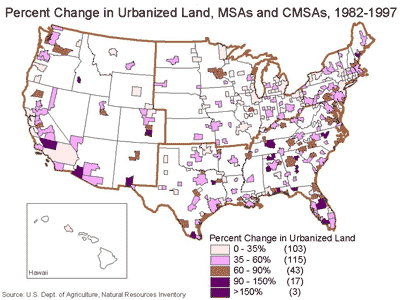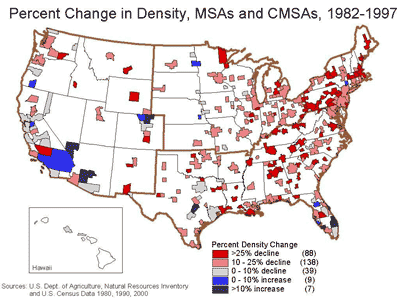Contrary to conventional wisdom, cities in the East are sprawling faster than their West coast counterparts.
 Most metropolitan areas are consuming land for urbanization much more rapidly than they are adding population. In that sense, most U.S. metro areas are "sprawling" more rapidly today than they have in the past. However, in many ways, the conventional wisdom about metropolitan densities and sprawl in the United States is inaccurate.
Most metropolitan areas are consuming land for urbanization much more rapidly than they are adding population. In that sense, most U.S. metro areas are "sprawling" more rapidly today than they have in the past. However, in many ways, the conventional wisdom about metropolitan densities and sprawl in the United States is inaccurate.
We define sprawl in terms of consumption of land resources only. In research for the Brookings Center on Urban and Metropolitan Policy, we calculated the density of every metropolitan area in the United States between 1982 and 1997. Density was defined as the population (estimated from the decennial census) divided by the urbanized land (derived from the National Resources Inventory's national survey of land use, conducted every five years). Our research was based on an actual measurement of urbanized land, rather than the Census Bureau's definition of "urbanized area," which does not measure land use.
 We found that many of the densest metropolitan areas in the United States are located in the West -specifically, in California, Arizona, and Nevada. The older metropolitan areas of the Northeast and Midwest also have historically high density at their core, but their recent development has sprawled dramatically, reducing their overall population density by large amounts in only 15 years.
We found that many of the densest metropolitan areas in the United States are located in the West -specifically, in California, Arizona, and Nevada. The older metropolitan areas of the Northeast and Midwest also have historically high density at their core, but their recent development has sprawled dramatically, reducing their overall population density by large amounts in only 15 years.
According to conventional wisdom, Western cities are sprawling because they are auto-oriented and older Northeastern and Midwestern cities are dense because they are dense in the aging core. In some sense, the conventional wisdom is correct. Western cities are auto oriented - that is, they do not have extremely dense old cores and they are built at densities that make it difficult to provide public transit alternatives. And in the Northeast and Midwest, older core areas continue to function at very high densities by national standards. They contain densely developed neighborhoods and business districts, and they often include a very high level of public transportation riders compared to national averages.
But at the scale of the metropolitan area, the conventional wisdom is wrong - at least so far as consumption of land for urbanization is concerned.
 Metropolitan areas in the Northeast and Midwest are consuming land at a much greater rate than they are adding population, and so their "marginal" density is extremely low. (Although they are adding population, Southern metro areas also have low marginal densities.) At the same time, the auto-oriented metropolitan areas of the West have overall metropolitan densities that are comparable to those in the Northeast and the Midwest. Furthermore, they are currently growing at much higher densities than their counterparts anywhere else in the nation. Western metro areas - whatever else their characteristics may be - are using less land to accommodate population growth than metro areas in any other part of the nation.
Metropolitan areas in the Northeast and Midwest are consuming land at a much greater rate than they are adding population, and so their "marginal" density is extremely low. (Although they are adding population, Southern metro areas also have low marginal densities.) At the same time, the auto-oriented metropolitan areas of the West have overall metropolitan densities that are comparable to those in the Northeast and the Midwest. Furthermore, they are currently growing at much higher densities than their counterparts anywhere else in the nation. Western metro areas - whatever else their characteristics may be - are using less land to accommodate population growth than metro areas in any other part of the nation.
There is no single problem of "sprawl" in the United States today; and there is no single solution. Rather, the problems associated with metropolitan growth throughout the nation are characterized by regional differences, and policy responses should be different as well.
William Fulton is President of the Solimar Research Group. Rolf Pendall is an Assistant Professor in the Department of City & Regional Planning at Cornell University and a Senior Research Associate at the Solimar Research Group. Mai Nguyen is a Ph.D. student in the Department of Urban Planning at the University of California, Irvine, and a Research Associate at the Solimar Research Group. Alicia Harrison is a Research Associate at the Solimar Research Group. This article was prepared from "Who Sprawls Most? How Growth Patterns Differ Across the U.S.," which was prepared for the Brookings Institution Center on Urban and Metropolitan Policy.

National Parks Layoffs Will Cause Communities to Lose Billions
Thousands of essential park workers were laid off this week, just before the busy spring break season.

Retro-silient?: America’s First “Eco-burb,” The Woodlands Turns 50
A master-planned community north of Houston offers lessons on green infrastructure and resilient design, but falls short of its founder’s lofty affordability and walkability goals.

Delivering for America Plan Will Downgrade Mail Service in at Least 49.5 Percent of Zip Codes
Republican and Democrat lawmakers criticize the plan for its disproportionate negative impact on rural communities.

Test News Post 1
This is a summary

Test News Headline 46
Test for the image on the front page.

Balancing Bombs and Butterflies: How the National Guard Protects a Rare Species
The National Guard at Fort Indiantown Gap uses GIS technology and land management strategies to balance military training with conservation efforts, ensuring the survival of the rare eastern regal fritillary butterfly.
Urban Design for Planners 1: Software Tools
This six-course series explores essential urban design concepts using open source software and equips planners with the tools they need to participate fully in the urban design process.
Planning for Universal Design
Learn the tools for implementing Universal Design in planning regulations.
EMC Planning Group, Inc.
Planetizen
Planetizen
Mpact (formerly Rail~Volution)
Great Falls Development Authority, Inc.
HUDs Office of Policy Development and Research
NYU Wagner Graduate School of Public Service


























